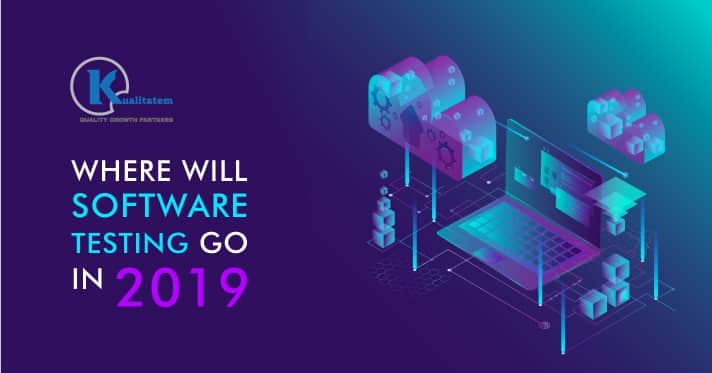Where Will Software Testing Go in 2019

- December 21, 2018
- Kualitatem
What a ride 2018. With the days growing shorter and time ticking every minute close to 2019, we just can’t help but look forward to a brand new year to start a different chapter in our lives. With so much happening, of course, the techies are looking forward to some amazing tech trends coming your way, including software testing trends.
No one can exactly tell what the future holds, but we’re taking our best shot making some predictions out of our own understanding and wisdom, not to mention experience in the field.
To begin with: here’s the first prediction to tip you off: Testing is going to go through a major transformation in 2019.
Without further ado, let’s see what our experts have to share with you about the testing scenario in 2019.
1. Testing fully enters the era of digital transformation
Digital transformation will remain as strong as it is right now. No matter how big or small your business is, what matters is how you interact with your clients and deliver your products and services to your customers. To keep up with these rapidly evolving with customer expectations, development teams looking for ways to speed up time-to-market have budged to agile development processes.
Up until now, however, testing hasn’t kept pace. In 2019, that’s going to change for the better. Grasping that fast, continuous delivery of unified customer experience is a principal differentiator for every business, companies will certainly have to update their testing approach. Slow and expensive legacy practices will be swapped with improved automation and focus on continuous testing delivered during the course of the development process.
2. Testing will shift left… and rise above!
Since companies prefer faster and more frequent release of their web and mobile apps, and developers progress to keep up, the outdated approach where testing is reflected as the sole dominion of the QA team and is conducted almost only at the end of the development process is becoming a thing of the past.
This will push testing to “shift left” in 2019. You will see teams executing automation testing meaningfully earlier in the development pipeline. Besides, not only the volume of tests will increase, the variety of tests will increase as well. So far, even the early adopters who shifted left have done so mainly with functional tests to determine whether something performs as expected functionally. In 2019, non-functional testing will also shift left, with teams opting to authenticate performance, security, and user experience earlier in the process.
3. Early pipeline testing shift to the cloud
With testing earlier in the development pipeline becoming the standard rather than the exception, development teams will progressively use the cloud in 2019 to control costs and acquire the agility to for testing quickly at a large scale. Previously, one of the main barricades stopping enterprises from executing testing earlier in the development pipeline has been the time and cost related with creating the application infrastructure. As the burden of the new digital economy turns early pipeline testing from a good-to-have to a must-have, enterprises will pursue fast, reliable, and cost-efficient solutions, and will shift to the cloud.
4. Headless makes headway
Continuous testing, now effectively, a prerequisite for teams for delivering high-quality apps at the speed their users request for, testing will continue to be pushed earlier in the process, giving developers quick feedback soon as they finish coding a section.
This quick feedback speeds up developer’s productivity since it’s easier to fix bugs in code that was previously written than in code written hours or days before. Unluckily, traditional cross-browser testing clouds every so often can’t come across the volume, frequency, and speed requests essential for these early-stage testing use cases.
Heedless testing combines new technologies, comprising of headless browsers and containers for giving developers quick access to fast and dependable test results at a lucrative price point by. In 2019, we’ll see a significant rise in the popularity of this transformative infrastructure methodology.











